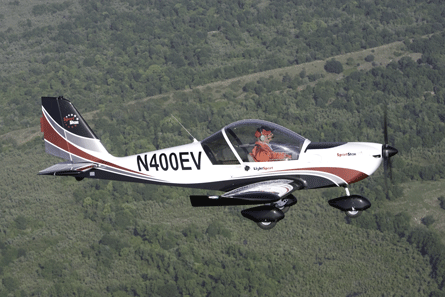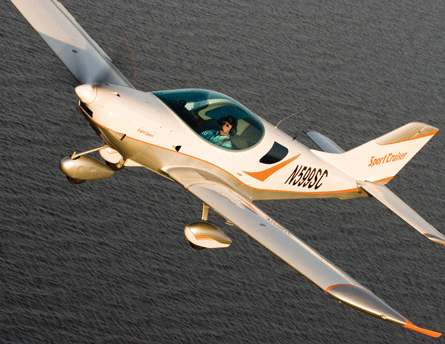Although the light sport category is taking off in the USA faster than manufacturers can build aircraft, not all flight schools are taking notice. But that is starting to change
Light sport aircraft are proving to be a good thing for those flight schools in the USA that have bought them. Yet most schools have yet to take the plunge to offer sport pilot certificates as the first step into aviation.
"It's still difficult to become a sport pilot today. That's because the aircraft are just arriving at flight schools," says Ron Wagner. As manager of field relations for the Experimental Aircraft Association, he is constantly introducing LSAs to schools and potential pilots. "It cuts everything in half," he says, like training time and fees and, sometimes, operating costs.
Wagner predicts better fortunes after counting the turnout at his workshops for chief flying instructors at the US Sport Aviation Expo in Sebring, Florida in January. "While lightly attended in the past, they were well-attended this year. That's a good sign that the flight schools are finally starting to take notice."
Growth is fastest in "smaller communities, particularly in touristy areas, like Florida and California", Wagner says, and the new category is not poaching business from private pilot training. As of February, the Federal Aviation Administration recorded 2,078 sport pilots and 220,566 private pilots in the USA.
New money
In a tour of flight schools in southwestern states that own LSAs, Wagner and Light Aircraft Manufacturers Association chairman Dan Johnson asked that very question. "All 22 flight schools said 'No, it's new money'," Johnson says, "And that was the most encouraging statement we could have heard."
Distributor Doug Hempstead has noticed the same thing with each of the 22 Czech-built Allegro 2000 models his company Fantasy Air USA has delivered to schools. He also runs B Bar D Aviation and first instructed sport pilots there two and a half years ago. Where the LSA is catching on it is definitely appealing to new people, he says, adding: "This is something aviation desperately needs: those 20 or 30-somethings getting into aviation, not just the 40- or 50-year-olds."

Nonetheless, "there's an awful lot of confusion out there," Hempstead says. Sometimes prospective students or even instructors confuse sport pilot with the all-but-obsolete recreational pilots licence or the ultralight category, which lives on.
Pushed into a PPL
Even if a new student wants be a sport pilot, Johnson says, they can be diverted by the instructor. "Rather than reveal that they don't know it very well they move people to what they do know, which is private pilot." A PPL typically costs $8,000-10,000 with at least 40h of flight time, he says, while a fixed-wing sport pilot programme costs as little as $2,500 with as few as 20h. In reality, Johnson says, most students train for 30-35 hours.
The LSA category does cover powered parachutes (12h of training), trikes (20h), gliders (10h), gyroplanes (20h), airships (20h) and balloons (7h). "Nobody walks in and says I want to get my air transport pilots licence," says Johnson. "People start with the first step. The way to do that is by sport pilot."
Says Wagner: "We can make a major reduction in the dropout rate and improve the success rate because getting a sport pilot licence is a level of achievement that lasts. Even if you don't fly for five years you can always go back, take a check-out and resume. It just takes a couple more hours along the way to take that check ride and become a private pilot."
For many older private pilots, the LSA is a way to keep flying. "If you want to exercise sport pilot privileges and use your driver's licence in lieu of a medical certificate, you simply let your medical certificate expire," Wagner says. Like all sport pilots, they give up night flying and become restricted to two-seat aircraft that do not exceed 120kt (220km/h) or weigh more than 1,320lb (600kg).
As the US pilot population ages, can the switch to sport pilot be tracked? "Unfortunately no, because the rule is so consumer friendly," Wagner says. Private pilots can operate as sport pilots without reporting to anyone except their insurance companies. Pilots who have been denied medical approval could be healthy enough to fly as sport pilots, but after years of effort to open that door, the EAA seems to have accepted that the FAA will not budge. "What we are having success at is working with the FAA to make the process of special issuance quicker and more efficient, and bringing FAA standards up to the 21st century," he says.
In 2009 Cessna will deliver its first LSA, the Model 162 Skycatcher, which Wagner predicts will have exponential impact through Cessna Pilot Centres. "Cirrus is another big name that's entered the industry. Once these aircraft hit the flight schools"
The current leader in number of LSAs delivered is Germany's Flight Design with 229 of its CT models in the USA, 20% of all new LSAs there. Flight Design USA president Tom Peghiny says the company has only delivered 12 CTs to flight schools but its new CTLS model, introduced at Sebring, was designed to quickly expand that. "Initially it was for sport pilot training and we have had more and more requests for the aircraft to be set up for PPL training as well. That is why we are offering the Dynon [avionics] system with the Garmin SL30 that allows monitoring VOR. We equip the aircraft with night flight equipment as well. It was an option before, now every CTLS has it," he says. Expecting to train pilots for more advanced aircraft, "many of our flight schools that we're contacting are asking for Garmin 430W that we are offering as an option."
LSA benefit
Though LSA operating costs are almost always lower than for the old Cessnas and Beechcraft flight schools have, none are being used solely for private pilot training. As Johnson puts it, "if they're savvy enough to accept the aircraft, then they know about the benefits of training for sport pilot". And, since the LSA is a new aircraft, schools often charge more to rent one than for a Cessna 152. All sport pilot flight training can be performed in that same 152, except for the solo.
Czech manufacturer Evektor holds the lead in LSA deliveries to US flight schools. According to Barry Pruitt, director of products and customer support for Evektor Aircraft, "there are 24 of them total right now in flight schools out of the 84 that are in the country. Several of them have made it to [the engine overhaul interval] already, so that means they've been high use: 1,500h on the Rotax in two years - that's pretty good usage." Evektor Aircraft only recently replaced Evektor America as the American distributor after disgreements with the Czech manufacturer.

In July 2005 two SportStars helpedSt Charles Flying Service in St Louis become the first flight school with a complete LSA programme, and owner Dennis Bampton says it may be ready to buy another. "We trained people from as far away as Washington State as well as from the North East. Since we started, we have licensed in excess of 40 new sport pilots in as little as two weeks training time." Bampton laments the distributor's switch. "Our marketing was assisted greatly by Evektor, and with their current situation that source of exposure has gone away. We now market the sport license in the same manor as we do our other training programmes," he says.
"The programme is still going rather well, but has slowed considerably with all the other sport schools cropping up," Bampton says. St Charles has accumulated 2,400h on the aircraft, depending first on booklets and online pre-training programmes. "We use the Gleim Ground Study programme and it has worked rather well in getting students their written [exam] pass prior to coming here."
Sport Aircraft Works partnered with Gleim to recreate its SportCruiser in a PC-based simulator that is "the first simulator designed specifically for sport pilot training", says Bob Anderson, sales and marketing director. The company offers a complete training programmes for flight schools that Anderson compares to a Cessna Pilot Centre programme.

Infrastructure needed
A dozen of the four LSA models Tecnam manufactures are in US flight schools, says distributor Lynne Birmingham. "We have not really attacked the flight school market yet," she says. "If you don't have the support infrastructure, I think it would be damaging to a company, and certainly it would be dangerous for a flight school to accept it unless they know they have the support."
The next reading on flight instructor interest in sport pilots will come at Sun 'n' Fun in April. EAA has a strong presence at the Lakeland, Florida event, including sport pilot workshops, and the small aircraft will be lovingly parked before demo flights beckon to new pilots.
Source: Flight International



















